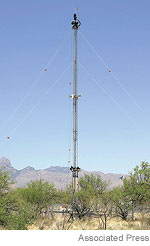February 28, 2008, - 12:45 pm
Michael Chertoff’s “Project 28”: Serpenthead’s (and Barack’s and Hillary’s) Failed Virtual Border Fence
By Debbie Schlussel
I saved this one from over the weekend, when it ran on the front page of the Saturday Wall Street Journal. (Since it’s only available to subscribers, the link is to another site that reprinted it.)
After wasting at least $84 millionon a “virtual fence,” the project is rife with problems and malfunctions. Yet Michael “Serpenthead” Chertoff “took delivery,” which means he accepts the problems and the fence “as is.” And he has no plans to have any more virtual fences after this . . . because it’s a failure.
As you read below about the problems with this phony border fence, their significance is great, as both Hillary Rodham Cankles Clinton and Barack Hussein Obama think a “virtual fence” is the way to go:
The government yesterday officially unveiled its $20
million “virtual fence,” touted for months as one of the most
effective ways to secure America’s leaky U.S.-Mexico border.


But the problems that have plagued the high-tech barrier mean that the fence’s first 28 miles will also likely be its last. The Department of Homeland Security now says it doesn’t plan to replicate the Boeing Co. initiative anywhere else. A spokeswoman says there are no plans to expand the project beyond its first phase, although Homeland Security Secretary Michael Chertoff says “some elements” of the project may be used in other locations.
The effective mothballing of the concept is a setback for the
government’s border-protection efforts, an embarrassment for
politicians backing the idea of an electronic fence and a blow to
Boeing, the project’s designer. It will also do little to settle the
fractious politics of immigration, which continue to reverberate
around the campaign trail.
The virtual fence, called Project 28, came up during Thursday’s debate in Austin, Texas, when both Democratic presidential candidates
expressed their support for a high-tech alternative to the federal
government’s construction of a 12-foot-tall physical fence. That
project, begun last year, has elicited outcry from Texas property
owners and local officials.
“Let’s deploy more technology and personnel, instead of the physical
barrier,” said New York Sen. Hillary Clinton. Barack Obama of Illinois agreed: “There may be areas where it makes sense to have some fencing. But for the most part, having [the] border patrolled, surveillance,deploying effective technology, that’s going to be the better approach.” Both senators had earlier voted for legislation mandating 700 miles of physical fence in sections of California, Arizona and Texas. . . .
Project 28 was based on off-the-shelf technology tied together by
Boeing. Cameras and radar mounted atop 98-foot towers would pick out
smugglers and illegal immigrants from miles away, allowing fewer
agents to patrol a given stretch of border. Command centers and mobile communications systems were also part of the contract.
But getting all these elements to work together harmoniously has
proven problematic. Project 28’s technology problems included software integration issues and difficulty getting the towers’ cameras to synch with the radar systems. The radar had trouble identifying objects amid desert scrub and trees. Rain posed problems to the surveillance systems, and concerns persist that the towers are tempting targets for increasingly well-armed drug gangs looking to shut down the system. . . .
Last month during a tour, customs and border-patrol officials showed
Attorney General Michael Mukasey the rugged terrain that Project 28
oversees. A Homeland Security Blackhawk helicopter soared above a vast expanse of breathtaking jagged desert peaks, amid which Project 28 towers stood their sentinel watch over the border. “Admittedly, we
gave Boeing some of the roughest parts of the border to work with,” a
border-patrol official told the attorney general, explaining what he
said were many problems the system had encountered.
In August, Boeing replaced the manager of Project 28. For months,
Boeing and Homeland Security wouldn’t say when the work was going to be complete. In early December, the government said it was closing in
on taking delivery. But that same month, the government gave Boeing another $64 million contract to fix the “common operating picture,” which lets agents in vehicles see imagery from the towers’ surveillance systems. Yesterday’s announcement marked the final end of the testing period.
Homeland Security officials took possession of the system over the objections of Congress, which has been critical of the department and of Boeing for the problems that have bedeviled the program. “We are no safer and out millions of dollars,” said Democratic Pennsylvania Congressman Christopher Carney, oversight chairman in the House Homeland Security committee. “We were led to believe that this was going to be a Beta test for a virtual fence for the border. Certainly this is not the force multiplier it was supposed to be.”
And it’s not the solution to our border problems. A physical fence, profiling, tougher immigration enforcment, and limits on Muslim immigration to America are. Don’t expect any Beta tests on those . . . ever.
Tags: America, Arizona, Attorney General, Austin, Barack Hussein Obama, Boeing Co., Border Patrol official, California, Christopher Carney, Congress, Debbie Schlussel, Department of Homeland Security, designer, federal government, high-tech alternative, high-tech barrier mean, Hillary Clinton, Hillary Rodham Cankles Clinton, Homeland Security Secretary, House Homeland Security Committee, Illinois, manager of Project, Mexico, Michael "Serpenthead" Chertoff, Michael Chertoff, Michael Mukasey, mobile communications systems, New York Sen, oversight chairman, Project 28 towers, radar systems, spokeswoman, surveillance systems, technology problems, Texas, the Saturday Wall Street Journal, U.S.-Mexico border, United States, USD


The only effective way to secure the border requires a combination of a physical barrier and patrols conducted 24/7.
The High Tech stuff is neat but only a supplement to the basics.
This ISN’T rocket science….it IS (sadly) politics.
SamAdams on February 28, 2008 at 4:00 pm